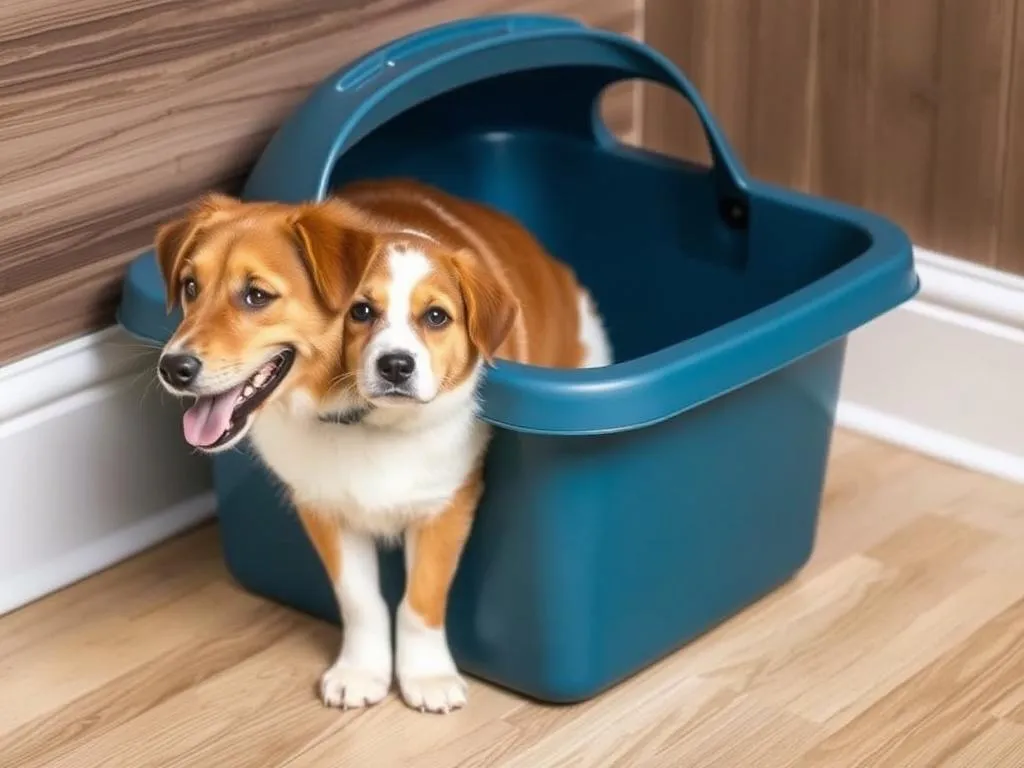
Dogs getting into cat litter boxes can be a frustrating and messy problem for pet owners. It’s not just about the annoyance; this behavior can pose significant health risks for our furry friends. Understanding the reasons behind this behavior, as well as effective strategies to prevent it, is crucial for maintaining a harmonious household. Here’s a detailed look at how to keep dogs out of the cat litter box.
Understanding the Behavior
Why Dogs Are Attracted to Cat Litter
Dogs are naturally curious creatures, often driven by their instincts. This curiosity can lead them to investigate their environment, including the cat litter box. The scent of cat litter can be particularly appealing to dogs. Cats have a different diet than dogs, and the smell of cat waste can pique a dog’s interest as they explore their surroundings.
Moreover, the playful nature of dogs makes them more likely to engage with objects that capture their attention. A litter box, with its unique textures and smells, can appear as an intriguing toy or puzzle to a dog, beckoning them to explore further.
Health Risks of Dogs Eating Cat Litter
The urge to dig into cat litter isn’t just a behavioral issue; it can also pose serious health risks. Dogs that ingest cat litter can face a variety of problems, including:
- Parasites and Bacteria: Cat waste can carry parasites like Toxoplasma gondii, which can be harmful if ingested by dogs. Additionally, bacteria present in cat feces can lead to gastrointestinal issues.
- Digestive Problems: Eating litter can cause blockages in a dog’s digestive system, leading to discomfort, vomiting, or even more severe conditions that may require veterinary intervention.
- Toxic Ingredients: Some types of cat litter contain chemicals that can be harmful if ingested, adding another layer of risk for your dog.
Preventing this behavior is essential for ensuring the health and well-being of both your dog and cat.
Preventative Measures
Choosing the Right Litter Box
One of the first steps in how to keep dogs out of cat litter box is selecting the right litter box. The type and placement of the litter box can significantly impact a dog’s access to it.
- Types of Litter Boxes: Consider using a covered litter box. Covered boxes can deter dogs from accessing the litter while still allowing cats to enter comfortably.
- Placement: Place the litter box in an area that is away from your dog’s primary living space. A secluded corner or a room that is off-limits to your dog can help keep them away from the litter box.
- Size Considerations: Ensure the litter box is appropriately sized for your cat. If the box is too small or not easily accessible for your cat, they may avoid using it, leading to messes elsewhere.
Training Your Dog
Training your dog to respect boundaries is another effective measure.
- Basic Obedience Training: Implement basic commands like “leave it” or “stay.” These commands can be reinforced by practicing them consistently.
- Reinforcing Boundaries: Use positive reinforcement to reward your dog for staying away from the litter box. Treats and praise can help reinforce this behavior.
- Using Commands: Whenever your dog approaches the litter box, use a firm command to deter them. Ensure that all family members are consistent in using the same commands and strategies.
Using Barriers
Sometimes, physical barriers are necessary to keep dogs away from the litter box.
- Physical Barriers: Baby gates can be an effective way to block access to the litter box. Place a gate in the doorway of the room where the litter box is located, allowing only your cat to pass through.
- Creative Solutions: Consider placing furniture strategically to block the dog’s access to the litter box. Alternatively, look into litter box enclosures designed specifically to keep dogs out while allowing cats easy entry.
Behavioral Modification Techniques
Redirecting Attention
Redirecting your dog’s attention is a proactive approach to prevent them from getting into the litter box.
- Providing Alternative Distractions: Offer your dog toys or activities that can divert their attention from the litter box. Puzzle toys or chew toys can keep them engaged.
- Engaging Dogs in Other Areas: Make sure to engage your dog in play or training sessions in areas away from the litter box. Creating a designated play zone can help keep their focus elsewhere.
- Regular Exercise and Mental Stimulation: A well-exercised dog is less likely to seek out trouble. Regular walks, playtime, and mental challenges can significantly reduce your dog’s curiosity about the litter box.
Positive Reinforcement
Using positive reinforcement is a powerful method to encourage your dog to avoid the litter box.
- Rewarding Dogs for Ignoring the Litter Box: Whenever your dog passes by the litter box without showing interest, reward them with treats or praise. This helps reinforce the desired behavior.
- Creating a Routine: Establish a routine that discourages access to the litter box, such as supervised playtime followed by rest in another room.
- Building Positive Behavior Habits: Consistency is key. Over time, your dog will learn that ignoring the litter box leads to rewards, thereby creating a habit of avoidance.
Cat-Specific Solutions
Litter Box Design
The design of your cat’s litter box can also influence your dog’s behavior.
- High-Sided Litter Boxes: Opt for high-sided litter boxes that are harder for dogs to access. This can be especially effective for larger dogs.
- Litter Boxes with Cat Flaps: Consider using a litter box with a cat flap. This design allows your cat to enter while keeping larger dogs out.
- Cat Litter Box Furniture: There are stylish litter box enclosures available that blend with home decor while keeping dogs away from the box.
Teaching the Cat
While the focus is often on training dogs, teaching your cat can also contribute to a solution.
- Training Cats to Use the Litter Box Efficiently: Ensure your cat is comfortable using the litter box. A stressed or anxious cat may avoid the box, leading to messes.
- Providing Multiple Litter Boxes: If you have multiple pets, consider providing several litter boxes in different locations. This ensures that your cat has accessible options without attracting the dog.
- Keeping the Litter Box Clean: Regular cleaning of the litter box can help reduce the odors that may attract your dog. A clean box is less enticing to curious noses.
Monitoring and Adjusting
Observing Behavior
Keeping an eye on your pets’ interactions is crucial for successful management.
- Keeping an Eye on Both Pets’ Interactions: Observe how your dog and cat interact around the litter box. This can help you identify moments when your dog is more likely to investigate.
- Identifying Triggers: Pay attention to triggers that lead to your dog’s interest in the litter box. Is it when they are bored or after a meal? Identifying these triggers can help you adjust your strategy accordingly.
- Adjusting Strategies Based on Observations: Be prepared to modify your approach based on your observations. If one method isn’t working, try another until you find what works best for your household.
When to Seek Professional Help
Sometimes, the situation may require professional intervention.
- Signs It May Be Time to Consult a Veterinarian or Animal Behaviorist: If your dog’s behavior worsens or if you notice other concerning signs, it may be time to seek help. A professional can provide insights and tailored strategies.
- Options for Professional Training or Behavioral Assessment: Look into local trainers or behaviorists who specialize in multi-pet households. They can offer personalized guidance based on your specific situation.
- Importance of Addressing Underlying Issues: Don’t overlook the possibility of underlying behavioral or health issues. Addressing these can lead to a more harmonious household for all your pets.
Conclusion
Keeping dogs out of the cat litter box requires a combination of understanding, prevention, and training. By implementing the strategies discussed, pet owners can create a safer environment for both their dogs and cats. Remember to be patient and consistent with your training efforts. With time and the right approach, it’s possible to maintain a peaceful coexistence between your furry friends, ensuring a harmonious home for everyone.
Encouraging responsible pet ownership not only enhances the lives of our pets but also contributes to a healthier, happier household.









